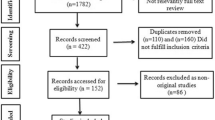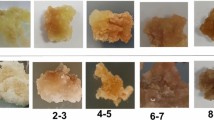Abstract
Morinda citrifolia L. belongs to family Rubiaceae. It is a traditional Polynesian medicinal plant. Its root serves as a rich source of various anthraquinone constituents. The anthraquinone compounds exhibit therapeutic effects of antibacterial, antiviral and anticancer activities. In the present work, an adventitious root culture of M. citrifolia was established and the effectiveness of various elicitors viz, yeast extract, xylan, pectin and the precursor α-ketoglutaric acid on the level of anthraquinone production in adventitious root cultures were assayed. Adventitious root proliferation was achieved in Murashige and Skoog liquid medium supplemented with 24 μM Indole-3-butyric acid. The anthraquinone content was determined by spectrophotometric analysis and the anthraquinone constituents–viz, alizarin and purpurin were quantified by high-performance liquid chromatographic method. Enhancement in alizarin and purpurin along with total anthraquinones was detected due to the addition of precursor and elicitors. Pectin (20 mg/l) added cultures resulted in highest anthraquinone accumulation (44.4 mg/g dw). The protocol developed for the regeneration of roots was simple, reproducible and reliable for the possible commercial production of in vitro root biomass based alizarin and purpurin.




Similar content being viewed by others
References
Nelson SC (2006) Species profile for pacific island agroforestry. www.traditionaltree.org. Accessed in April 2012
Wang MY, Brett JW, Jensen CJ, Nowicki D, Su C, Paul AK, Anderson G (2002) Morinda citrifolia (Noni): a literature review and recent advances in Noni research. Acta Pharmacol Sin 23:1127–1141
Treetip R, Sumon T, Pranee N (2008) In vitro genotoxic and antigenotoxic studies of Thai Noni fruit juice by chromosomal aberration and sister chromatid exchange assays in human lymphocytes. Songklanakarin J Sci Tech 30:583–589
Sreeranjini S, Siril EA (2011) Evaluation of anti-genotoxicity of the leaf extracts of Morinda citrifolia Linn. Plant Soil Environ 57:222–227
Baque MA, Hahn E, Paek K (2010) Growth, secondary metabolite production and antioxidant enzyme response of Morinda citrifolia adventitious roots as affected by auxin and cytokinin. Plant Biotechnol Rep 4:109–116
Han YS, Van Der Heijden R, Verpoorte R (2001) Biosynthesis of anthraquinones in cell cultures of Rubiaceae. Plant Cell Tissue Organ Cult 67:201–220
Komaraiah P, Kavikishore PB, Carlsson M, Magnusson KE, Mandenius CF (2005) Enhancement of anthraquinone accumulation in Morinda citrifolia suspension cultures. Plant Sci 168:1337–1344
Hahn EJ, Kim YS, Yu KW, Jeong CS, Paek KY (2003) Adventitious root cultures of Panax ginseng C A Meyer and ginsenoside production through large-scale bioreactor system. J Plant Biotech 5:1–6
Kim SY, Hahn EJ, Murthy HN, Paek KY (2004) Adventitious root growth and ginsenoside accumulation in Panax ginseng cultures as affected by methyl jasmonate. Biotechnol Lett 26:1619–1622
Murthy HN, Hahn EJ, Paek KY (2008) Adventitious roots and secondary metabolism. Chin J Biotechnol 24:711–716
Bassetti L, Tramper J (1995) Use of non-conventional media in Morinda citrifolia cell cultures. Plant Cell Tissue Organ Cult 43:93–95
Bassetti L, Tramper J (1995) Increased anthraquinone production by Morinda citrifolia in a two-phase system with Pluronic F-68. Enzyme Microb Tech 17:353–358
Kieran PM, O’Donnell HJ, Malone DM, MacLoughlin PF (1995) Fluid shear effect on suspension cultures of Morinda citrifolia. Biotech Bioeng 45:415–425
Stalman M, Koskamp AM, Luderer R, Veernoy JHJ, Wind JC, Wullems GJ, Croes AF (2003) Regulation of anthraquinone biosynthesis in cell cultures of Morinda citrifolia. J Plant Physiol 160:607–614
Baque MA, Shiragi MHK, Lee E-J, Paek K-Y (2012) Elicitor effect of chitosan and pectin on biosynthesis of anthraquinones, phenolics and flavanoids in adventitious root suspension cultures of Morinda citrifolia (L.). Aust J Crop Sci 6:1349–1355
Sreeranjini S, Siril EA (2013) Production of anthraquinones from adventitious root derived callus and suspension cultures of Morinda citrifolia L. in response to auxins, cytokinins and sucrose levels. Asian J Plant Sci Res 3:131–138
Murashige T, Skoog F (1962) A revised medium for rapid growth and bioassays for tobacco tissue cultures. Physiol Plant 15:473–497
Godoy-Hernandez G, Vazquez-flota FA (2006) Estimation of cell division and cell expansion. In: Loyola-Vargas M, Vazquez-flota FA (eds) Methods in molecular biology, plant cell culture protocols. Humana Press, New York, pp 51–58
Hangendoorn MJM, Jamar DCL, Van der plas LHW (1994) Directing anthraquinone accumulation via manipulation of Morinda suspension cultures. In: Hall RD (ed) Methods in molecular biology, plant cell culture protocols, vol III. Humana Press, New York, pp 383–392
Roy A, Lakshmi T, Geeta RV (2012) Estimation of quercetin in Acacia catechu ethanolic bark extracts by HPLC method. Int J Pharm Tech Res 4:501–505
Snedecor GW, Cochran WG (1962) Statistical methods, 4th edn. The Iowa State University Press, Iowa
Carvalho EB, Curtis WR (1998) Characterization of fluid flow resistance in root cultures with a convective flow tubular bioreactor. Biotechnol Bioeng 60:375–384
Wu CH, Dewir YH, Hahn E-J, Paek KY (2006) Optimization of culturing conditions for the production of biomass and phenolics from adventitious roots of Echinacea angustifolia. J Pant Biol 49:193–199
Cosio EG, Frey T, Verduyn R, Bhoom JV, Ebel J (1990) High-affinity binding of a synthetic hepatoglucoside and fungal glucan phytoalexin elicitors to soybean membranes. FEBS Lett 271:223–226
Menke FL, Parchmann S, Mueller MJ, Kijne JW, Memelink J (1999) Involvement of the octadecanoid pathway and protein phosphorylation in fungal elicitor-induced expression of terpenoids indole alkaloid biosynthetic gene in Catharanthus roseus. Plant Physiol 119:1289–1296
Zhao J, Zhu WH, Hu Q, Guo YG (2001) Elicitor induced indole alkaloid biosynthesis in Catharanthus roseus cell cultures is related to Ca2+ influx and the oxidative burst. Plant Sci 161:423–431
Quevedo C, Perassolo M, Alechine E, Corach D, Giulietti AM, Talou JR (2010) Increasing anthraquinone production by over expression of 1-deoxy-D-xylulose-5-phosphate synthase in transgenic cell suspension cultures of Morinda citrifolia. Biotechnol Lett 32:997–1003
Guo ZG, Liu Y, Gong MZ, Chen W, Li WY (2013) Regulation of vinblastine biosynthesis in cell suspension cultures of Catharanthus roseus plant cell. Tissue Organ Cult 112:43–54
Takahashi E, Marczylo TM, Watanabe T, Nagai S, Hayatsu H, Negishi T (2001) Preventive effects of anthraquinone food pigments on the DNA damage induced by carcinogens in Drosophila. Mutat Res 480–481:139–145
Kaur P, Chandel M, Kumar S, Kumar N, Singh B, Kaur S (2010) Modulatory role of alizarin from Rubia cordifolia L. against genotoxicity of mutagens. Food Chem Toxicol 48:320–325
Acknowledgments
The authors are thankful to the University of Kerala, Thiruvananthapuram, India for granting University JRF (No: Ac.E1/5825/09) and they thank Dr Ashalatha S Nair, Professor and Head, Department of Botany and Dean, Faculty of Science, University of Kerala for the facilities provided.
Author information
Authors and Affiliations
Corresponding author
Rights and permissions
About this article
Cite this article
Sreeranjini, S., Siril, E.A. Optimising Elicitors and Precursors to Enhance Alizarin and Purpurin Production in Adventitious Roots of Morinda citrifolia L.. Proc. Natl. Acad. Sci., India, Sect. B Biol. Sci. 85, 725–731 (2015). https://doi.org/10.1007/s40011-014-0395-7
Received:
Revised:
Accepted:
Published:
Issue Date:
DOI: https://doi.org/10.1007/s40011-014-0395-7




